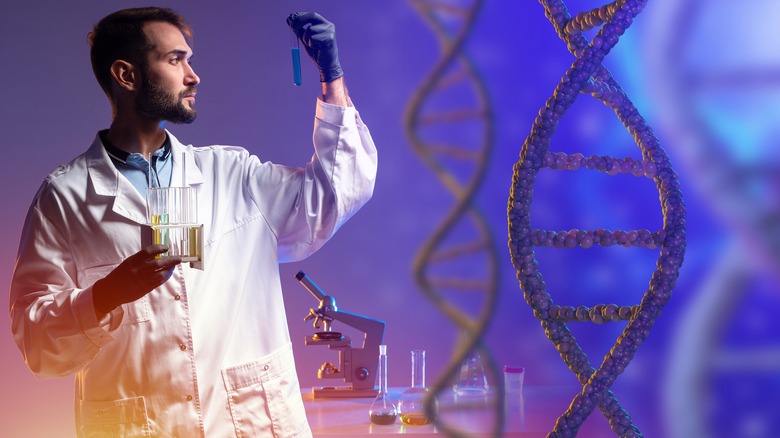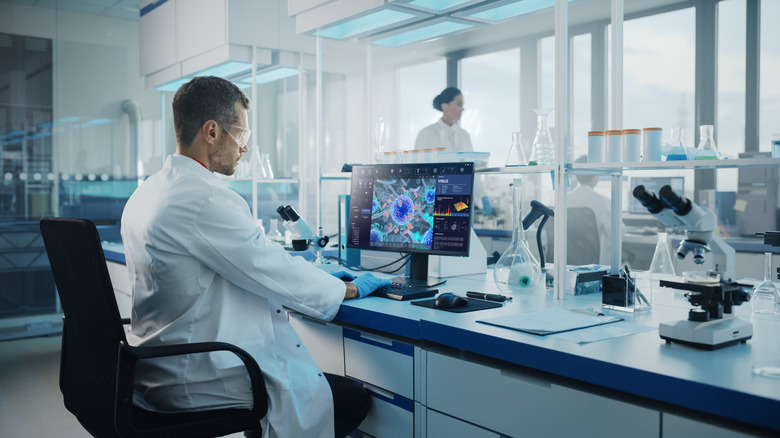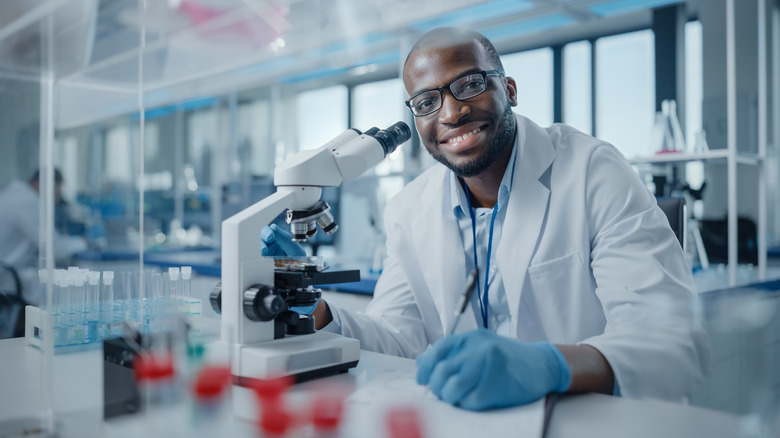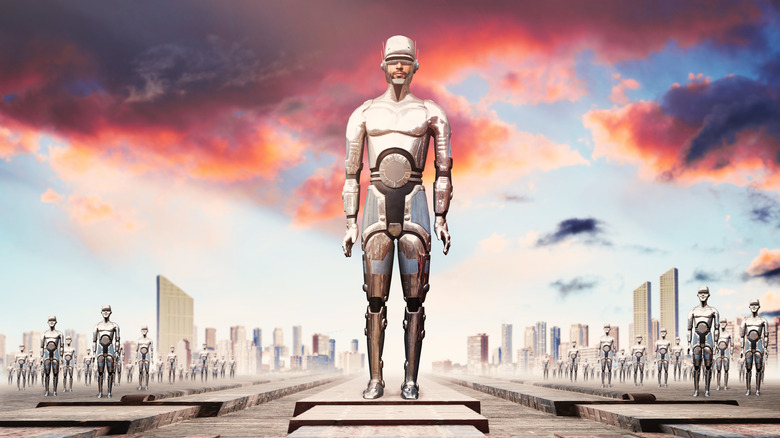Here's How You Can Watch Movies With DNA
When it comes to the building blocks of anatomy, deoxyribonucleic acid, more commonly referred to as DNA, ranks pretty high. According to Be Smart, every single cell in the human body contains the equivalent of two meters of DNA, which is snuggly tucked into a nucleus measuring ten-millionths of a meter from one side to the other. National Geographic reports that after a great deal of head-scratching, scientists roughly estimate that the average human contains 37.2 trillion cells, which adds up to over 60 billion miles of DNA in one single human body (per the National Institute of General Medical Sciences). In other words, DNA is as abundant as it is small, its double-helix shape spanning an unfathomable length from head to toe.
Given the sheer abundance of DNA in the human body, it's clear that it must have a pretty important job. It does — DNA is tasked with conveying the instructions the body needs to sustain itself and reproduce (via the National Human Genome Research Institute). In brief, DNA stores all the information necessary to sustain human life. But can it also store other information, like, for example, movie reels? Interestingly enough, yes (per the National Institutes of Health).
In 2017, scientists recorded and then replayed a vintage movie through the DNA of live bacteria
According to the National Institutes of Health, 2017 marks a year of marvel for vintage movie buffs and sci-fi enthusiasts alike. This was the year that scientists successfully uploaded and replayed a vintage motion picture via live DNA. Now, before you go ahead and cancel your Netflix subscription in lieu of catching all the classics through DNA streaming, there are some notable limitations to this groundbreaking new tech.
Firstly, the DNA the movie was embedded and replayed on was not human DNA. Rather, it belonged to live bacteria (via ScienceAlert). So, it wasn't a person binging Netflix on a new DNA encryption but a group of scientists watching an 1870s picture reel being played back through the DNA of intestine-dwelling E. Coli. Secondly, the movie portrayed wasn't a full-length theater-level production but a grainy vintage classic called "race horse in motion," which is basically a silent 16-second clip of a galloping horse that's historically known as the world's first-ever motion picture.
While the idea of streaming movies straight through DNA is pretty fascinating, it doesn't seem like the most practical thing for movie buffs to try. Fortunately, movie watching isn't really what scientists are setting the stage for with this advancement. Their goals are far more ambitious than that ...
The ultimate goal is to turn DNA into a molecular recorder
As you might imagine, binge-watching the latest episode of your favorite television show through the DNA of intestine-hungry bacteria was not really the main objective of this scientific exercise. Neuroscientist Seth Shipman spoke candidly on this subject, stating (via the National Institutes of Health), "We want to turn cells into historians."
According to Nature, this type of technology could potentially work in tandem with futuristic gene-editing equipment like CRISPR to trace sequences of events happening in the body on a cellular level. The idea of utilizing human DNA as a tracking system or "molecular recorder" of real-time events sounds like something that would come from movies as opposed to playing movies. In reality, though, the idea is inspired by aircraft data recording devices that rapidly monitor and document everything that happens on an airplane for the purpose of avoiding in-flight accidents or at least reducing fatality rates (via Boeing).
Much like a commercial flight, under DNA molecular recording, the body would be equipped with sensors that speak of previous gene-sequencing errors and potential dangers up ahead, opening up a window of possibility for editing and even manipulating gene sequencing. The implications of this are quite boundless, indeed, from a "Gattaca"-esque manufacturing of humanity to the possible elimination of life-threatening illnesses such as cancer and Alzheimer's. The fate of this rests on the shoulders of present and future scientists, for better or worse.
The movie was painstakingly embedded by way of electroporation
The Los Angeles Times reports that the process of uploading this five-frame, seconds-long "motion picture" was quite complex and time-consuming. To start, scientists referred to the process of electroporation, methodically casting temporary "pores" into cell membranes using short bursts of electricity (via Thermo Fisher Scientific).
Each single frame of the vintage film contained 104 DNA sequences and took an entire day to upload. As a point of reference, those old enough to remember Napster in its heyday might recall waiting this long for a single music file to burn onto a compact disc. And much like ancient music-swiping tech, the technique is not exactly perfect. After the GIF-style footage was completely uploaded to the genome, it still had to be run through a computer, and even then, it was proven to playback with a 90% accuracy rate, leaving a 10% margin for error.
Either way, the movie did a decent job of proving that bacteria's DNA is capable of storing and displaying information in sequential order. As an added bonus, it was also able to read the horse reel backward and play it from the end to the beginning, which is cool for anyone who's ever wanted to watch E. Coli show grainy slides of a horse galloping backward through a pasture.
This new development could help cure cancer
New developments in CRISPR technology could potentially give us unparalleled insight into infectious diseases, possibly even leading to cures and treatments for otherwise fatal conditions like late-stage cancer, for example (per the National Library of Medicine). According to Live Science, making use of electroporation — as scientists did when embedding the vintage horse footage into bacterial DNA — is a relatively new and promising concept in the field of cancer research. This is because the molecular recording technology can be used in tandem with CRISPR to not only detect genetic mutations and/or errors but also to alter or rewrite them, essentially ridding the body of the bad code causing the disease.
Prior to electroporation, scientists had to rely on ancient modified viruses in a process that took more time than most terminally ill patients had to spare. But just because the process is sped up doesn't make it perfect. Many healthcare professionals are concerned that gene editing could wipe out or alter unintended strands of DNA, causing new and unprecedented health hazards as a result. Then there are other professionals who believe the technology could wipe out or alter all of humanity, casting a dark and dystopian cloud over the petri dish of E. Coli we are all watching this movie on (via Time).
As a darker twist, it could also destroy the world
Time reports that there are several downsides to writing, recording, and rewriting DNA. For example, therein lies the temptation to edit each human to a degree of perfection, essentially rendering us pod people (or a robot race, if you will).
Another important point is that genetic coding isn't necessarily good or bad. In fact, in most cases, it is a blend. For instance, the genetic mutation that sometimes causes psychiatric disorders was found in the brains of 77% of fiction writers in a 1995 study. Genes that pose genetic risks often also contribute to favorable personality traits like intelligence and creativity. One might only imagine what could happen to the world if we started nipping and tucking the human personality as we now do the human body to the point where almost everyone on Instagram now essentially bares the same face (via PetaPixel).
New technologies also give scientists a window into the human brain through the manipulation of DNA (per ScienceDaily). As Dr. Seth Shipman, head of this study, goes on to explain, "Such a molecular recorder will allow us to eventually collect data from every cell in the brain at once, without the need to gain access, to observe the cells directly, or disrupt the system to extract genetic material or proteins."
Access to every single brain cell at once without the need to probe or even request permission, huh? Okay. Nothing dystopian to see here ...





